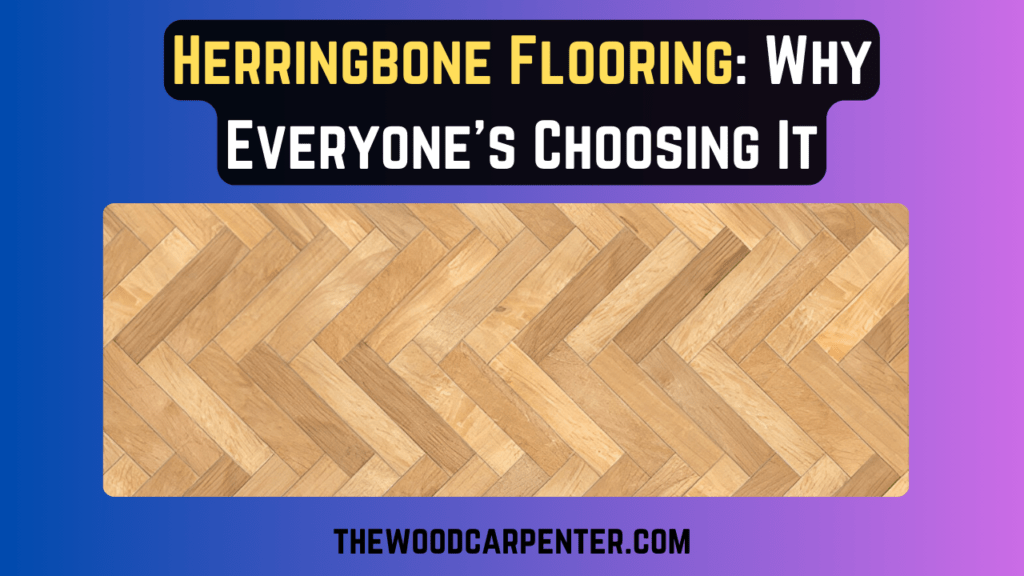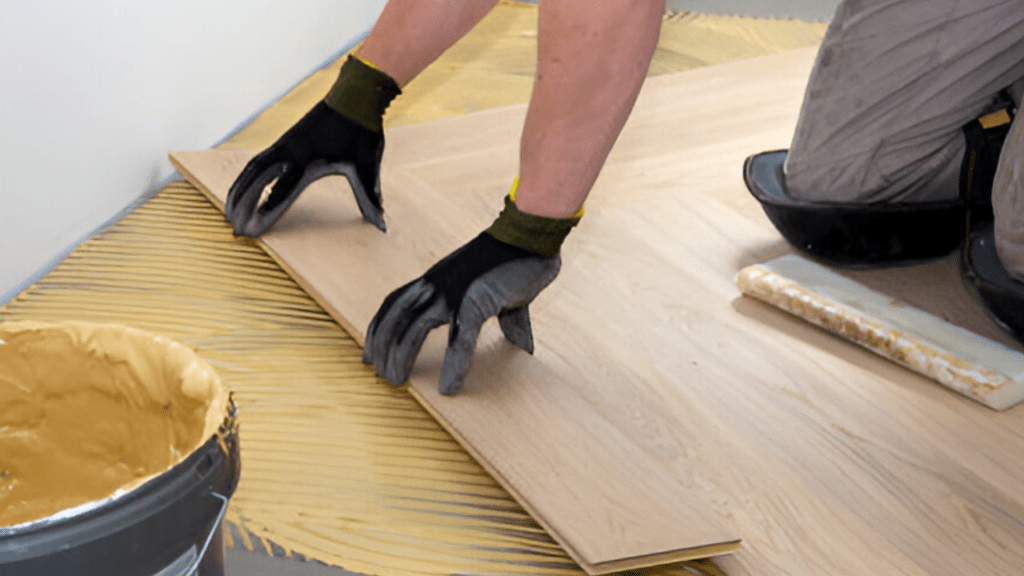
Herringbone flooring is known for its beautiful pattern and classy look. Whether you’re fixing up your home or building a new one, this type of flooring is a stylish and timeless choice. In this easy guide, we’ll talk about what herringbone flooring is, how to install and take care of it, and why it’s still so popular in home design.
What is Herringbone Flooring ?
Herringbone flooring is made by laying small wooden planks in a zigzag or V-shaped pattern. The design looks like the bones of a fish called a herring—this is where it gets its name. It started a long time ago in ancient Rome and has changed over the years, but it’s still seen as a sign of elegance and good taste.
The History of Herringbone Flooring
Herringbone patterns were first used in ancient Rome for roads and buildings. Later, people started using the design for floors, especially in castles and fancy homes. In the 1500s and 1600s, it became popular with rich families in Europe. Today, you can find herringbone floors not only in luxury places like hotels but also in regular homes and businesses.
Also read:
Manufactured Wood vs. Solid Wood: Which is Better ?
Why Choose Herringbone Flooring ?
Timeless Beauty
One of the main reasons people love herringbone flooring is because it never goes out of style. Its special pattern gives any room a classy and elegant feel.
It works well in both old-fashioned and modern homes. No matter what your style is, herringbone flooring brings charm and character to your space.
Flexible and Stylish
Herringbone flooring is very flexible in how and where you can use it. It comes in different materials like wood, vinyl, and laminate, so you can pick what works best for your home and budget.
It looks great in all kinds of rooms—kitchens, living rooms, hallways, and even bathrooms. You can also choose different sizes and directions for the pattern, giving you more options to match your design style.
Types of Herringbone Flooring
Solid Wood Herringbone Flooring
- Made from 100% natural hardwood (oak, walnut, maple).
- Can be sanded and refinished multiple times.
- Best for areas with stable humidity levels.
Engineered Herringbone Flooring
- Consists of a hardwood veneer over plywood or HDF core.
- More resistant to moisture and temperature changes.
- Ideal for kitchens, basements, and over underfloor heating.
Laminate Herringbone Flooring
- Budget-friendly alternative with a printed wood-like design.
- Scratch-resistant and easy to maintain.
- Suitable for high-traffic areas.
Luxury Vinyl Tile (LVT) Herringbone Flooring
- Waterproof and highly durable.
- Mimics real wood with realistic textures.
- Perfect for bathrooms and commercial spaces.
How to Install Herringbone Flooring ?
Installing herringbone flooring is a little trickier than regular flooring because of its detailed pattern. But with the right tools and a bit of patience, you can do it!

Getting Ready
Before you start, make sure the floor underneath (called the subfloor) is clean, flat, and dry. If you’re using wood or laminate planks, let them sit in the room for at least 2 days before installing.
This helps the material get used to the room’s temperature and stops it from expanding or shrinking later.
Tools and Materials You’ll Need
To install herringbone flooring, you’ll need:
- Flooring glue or adhesive
- A saw (to cut the planks)
- A tape measure
- A square (to help make straight lines)
- A mallet (soft hammer)
- Spacers (to keep even gaps)
- A utility knife (for cutting vinyl or laminate)
Easy Step-by-Step Instructions
- Plan the layout: Draw a grid or guide lines on the subfloor to help keep the pattern straight.
- Cut the planks: Use the saw to cut your flooring planks. Try to make clean cuts so the edges look neat.
- Glue it down: Spread the glue on the subfloor (if needed), and start placing the planks in the herringbone pattern. Make sure each piece fits snugly.
- Keep going: Keep laying planks across the room, one section at a time. Use spacers to keep the gaps even.
- Finish up: Once all the planks are down, let the glue dry (check the instructions for how long). Then, trim off any extra pieces along the edges to give it a neat look.
How Much Does Herringbone Flooring Cost ?
The price depends on the material you choose. Real wood and fancy parquet can be expensive. But if you’re looking to save money, laminate or vinyl herringbone flooring is a more budget-friendly choice—and it still looks great!
Factors Affecting Cost
Material: Real wood is usually the most expensive. Fancy parquet is also costly. Laminate and vinyl are cheaper options.
Room size: Bigger rooms need more flooring, which means a higher cost.
Installation: Hiring a professional to install it adds to the price, especially if the floor needs a lot of prep work.
Budget-Friendly Alternatives
If you want the herringbone look without spending too much, go for laminate or vinyl. They look great and cost much less than real wood.
Herringbone Flooring vs. Chevron Flooring
| Feature | Herringbone Flooring | Chevron Flooring |
| Pattern | Broken zigzag (90° angles) | Continuous “V” shape (45° angles) |
| Installation | More forgiving | Requires precise cuts |
| Visual Effect | Subtle, textured | Bold, uniform |
| Best For | Traditional & modern spaces | High-impact, contemporary designs |
How to Take Care of Herringbone Flooring?
Regular Cleaning
Herringbone flooring is easy to care for. Just sweep or vacuum often, and clean with a microfiber mop and a gentle cleaner made for your type of floor. If you have wood floors, use only a damp mop—don’t soak it with water.
Fixing Scratches or Damage
Over time, your floor may get some scratches. For wood, you can sand and refinish it to make it look new again. If you have laminate or vinyl, you can simply replace the damaged plank.
Common Mistakes to Avoid When Installing
Not preparing the subfloor: Make sure the floor underneath is clean, dry, and level before starting.
Skipping the acclimation step: Let your flooring sit in the room for at least 2 days before installing it. This helps it adjust to the room temperature.
Misaligned pattern: Make sure the herringbone pattern lines up properly all across the room.
Frequently Asked Questions (FAQs)
1. How long does herringbone flooring last?
With good care, this flooring can last for many years. Wood flooring can even last 50 years or more.
2. Is herringbone flooring good for kitchens?
Yes! Just choose water-resistant materials like vinyl or laminate for kitchen areas.
3. Can I install it myself?
Yes, you can if you have the right tools and follow the steps. If it feels too tricky, it’s better to hire a pro.
4. How do I clean wood herringbone flooring?
Use a soft mop and a little water. Avoid using too much water. Vacuum often to keep dust away.
5. What is the best material for herringbone flooring?
It depends on your budget and needs. Wood looks fancy and classic. Laminate and vinyl are cheaper and easier to care for.
6. Can I use it in bathrooms?
Yes, you can. But for wet areas like bathrooms, vinyl or waterproof tile is the best choice.
Conclusion: Why Herringbone Flooring is Worth It
Herringbone flooring adds a classy, stylish touch to any room. Whether you pick wood, laminate, or vinyl, it brings beauty and charm. With regular cleaning and care, herringbone flooring will make your home look great for many years.